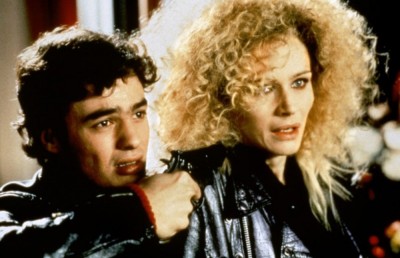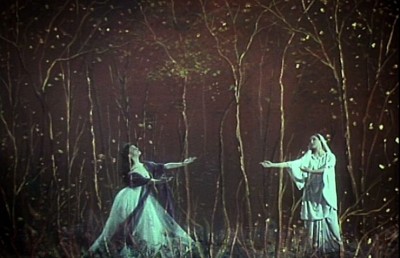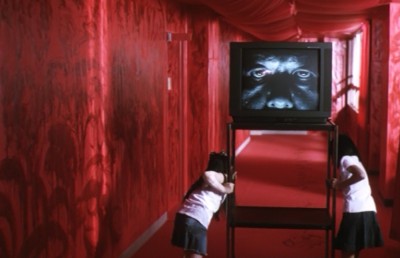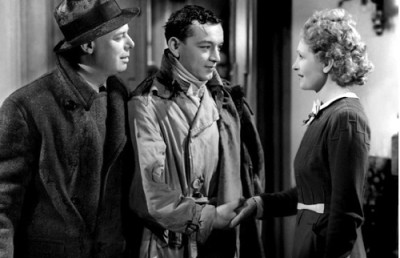Kieslowski and Besson Meet in Le Cercle Rouge
Odd Synchronicities
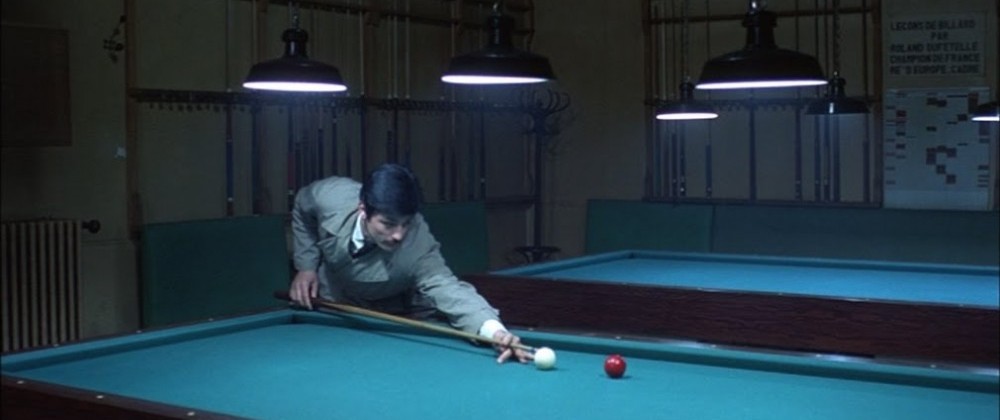
Ten years ago Krzysztof Kieslowski, the polish film maker, died on March 13 during a heart operation. I had only just discovered his work a few years earlier when I saw the trilogy, Trois Couleurs: Bleu, Blanc, Rouge (1993 – 1994), and then, all of a sudden it seemed, he was gone. Kieslowski’s films are subtly disarming because the extraordinary moments of understanding in his films are made of the most ordinary elements, as, for example, in Blue. Blue, the first film of the trilogy and my first Kieslowski film, left me dazed as I walked out of the theater. Julie (Juliette Binoche) survives a car accident where her husband and daughter are killed. She tries and fails to kill herself in body and then determines to kill herself in spirit. Julie ruthlessly abandons Patrice, a man who worships her. She tells him that she is like any other woman: She coughs. She sweats. She has cavities. While emptying out the house that she and her family shared, Julie finds her housekeeper sobbing in the pantry. She cries because Julie does not. Julie discovers her husband’s lover who is now pregnant with his child and gives the house to her husband’s lover. The real birth in the film is Julie’s. In the frames of the final sequence, her innocuous self-deprecation that she has cavities catches up with us. The ultrasound monitor of her husband’s unborn baby reads that the baby has” 4 _cavites_” – four chambers of the heart. What we took as a sign of decay was really an affirmation of a full and functioning heart. In the last frame, we see Julie naked and she finally cries, like any other new born. Ordinary, then extraordinary. I don’t know how Kieslowski creates this affect, and probably never will, but even now, years later, I find myself searching earlier films, his and others, for signs.
In the summer of 2003, I wasn’t really thinking of Kieslowski when I first saw Jean-Pierre Melville’s jewel-heist film, Le Cercle Rouge. Melville made this film in 1970, but it did not catch on in the United States. It was re-released through the efforts of the film maker John Woo. In it, I saw strands of another French director’s work, Luc Besson’s La Femme Nikita (1991). Not too surprising, since they are both highly stylized capers of a sort. I was surprised though when I saw echoes of Kieslowski’s last film of the trilogy, and the last film he made, Rouge. And though I never have, and probably never will, put Kieslowski and Luc Besson in the same category of director, they both seem to have crossed paths with Melville’s film.
Le Cercle Rouge starts with this quote attributed to “Rama Krishna”:
Siddhartha Gautama, the Buddha, drew a circle with a piece of red chalk and said: When men, even unknowingly, are to meet one day, whatever may befall each, whatever their diverging paths, on the said day, they will inevitably come together in the red circle.
The literary Polish director, who made films about chance, fate and serendipity, and the French director, whose most prominent film motif is violence (though efficient and even comic) and whose protagonists are—more likely than not—professional killers, seem to have met in the red circle.
The first scene in Le Cercle opens with a police car on its way to the train station carrying in the back seat Inspector Mattei and prisoner Vogel. As the car moves forward, Inspector Mattei’s face emerges from the shadows. His face is still, but his eyes are alert and impatient. A traffic light changes to red; the driver runs the light, narrowly misses another vehicle, and speeds to the Marseille –Blancarde train station. The station clock, filling the night like the full face of the moon, reads nearly midnight. In these first frames of Melville’s film, I knew that Kieslowski had to have watched Le Cercle. In his book, Kieslowski on Kieslowski, he talked about stealing from other films. Kieslowski said, “If somebody’s gone that way before and it’s proved to be good, then you have to steal it immediately.” [1] I’m only guessing, but I think he not only stole from Melville, but Kieslowski seems to have taken Melville’s red circle, a harbinger of crossed paths and near misses, and incorporated it into the very structure of Rouge.
Inspector Mattei is played by André Bourvil. The Italian actor Gian Maria Volonte plays Vogel. Handcuffed together, they board the train to Paris just as it pulls from the station. André Bourvil was a celebrated French comedic actor throughout the 1960s. But in Melville’s film, he was in a rare dramatic role. More than 35 years later, his presence in Le Cercle is still striking. Until 1970, he had starred, with enormous appeal, in films directed by Gerard Oury, Le Corniaud (The Sucker, 1965), La Grande Vadrouile, The Great Spree (1966), and Le Cerveau (The Brain, 1969). In these farces and capers, Bourvil often played the dim-witted willing (or unwilling) accomplice who eventually gained the upper hand over slapstick incompetent villains. In Le Cercle though, his intelligence is keen and piercing, and his performance is all the more remarkable given that during filming in the last months of winter and the spring of 1970, Bourvil was suffering from cancer. He died on September 23, 1970, a little more than three weeks before Le Cercle was released on October 21. [2]
The opening shot of the second scene of Le Cercle shows a man sleeping in a prison cell. The single source of light from the hall streams in through a disc above the door, which glows like the face of a clock with no hands. Corey (Alain Delon) is the sleeping man, and he has been in prison for five years. The jail guard slips into his room to tell him that he is to be released the next day—and about a plan for a jewel heist. Another guard on duty looks in through a round peep hole momentarily interrupting the exchange. Corey immediately pretends to be asleep, and the guard in the room hides in the corner. The complicity between the guard and prisoner is complete. Early and often in this film, Melville invokes the circle as a binding force. But he doesn’t stop at obvious connotations; the handcuffs shared by Inspector Mattei and Vogel are more than just two circles held together; they are the symbol of infinity itself—police officer and prisoner inextricably bound.
Shortly after boarding, Vogel escapes from the train (in a daring plunge, shattering the closed window), but he and Inspector Mattei, of course, meet again before it’s all over. Melville deliberately sets the narratives of Corey and Vogel on parallel paths. In Euclidean geometry, parallel lines never meet, but in a non-Euclidean world, one ruled by synchronicity and fate, where events loop back on themselves, parallel lines meet. They do so at infinity.
Corey and Vogel meet and immediately begin planning the heist. They need a marksman. Enter Jansen, an alcoholic ex-police officer played by Yves Montand. We first see Jansen holed up in his bedroom, empty liquor bottles, four deep from the wall. He is in the midst of hallucinations of snakes, lizards, rats, and tarantulas which emerge from the closet door and slither and teeter onto the bed. Montand can in one frame look like something washed out of a drain pipe, as he does when we first see him, and in the next be the essence of elegance itself, even if a little strained. Jansen and Corey first meet at Santi’s, the central locale of the film. Jansen’s first task is to scope out the electronic surveillance of Plouvier’s, the object of the heist. We see him strolling up a grand stair case of royal blue carpet and enters the show room pretending to examine bracelets and watches made with the world’s most precious stones. Montand looks as if he’s been appraising jewelry his entire life.
The heist is planned and Inspector Mattei continues to pursue Vogel. In Paris, Mattei faces the Chief Inspector who, not surprisingly, wants Vogel immediately back in custody. Vogel’s crime is never made clear, but when Mattei raises doubt about the guilt of his suspect, the Chief responds that though they may be born innocent, all men are, in the end, guilty. “Tous les hommes sont coupables,” he warns Mattei, “tous les hommes.”
Corey, Vogel, and Jansen (who sobers up and regains his steady hand) successfully pull off the heist. They are, however, unable to get rid of the jewels worth $20 million. The original fence bows out, and Mattei steps in and poses as the new one. The final sequence, which takes place at dusk, brings Vogel and Mattei again face to face (his meeting is just as dramatic as his initial escape, broken glass and all). First Jansen, then Vogel, and finally Corey are shot dead. After the police cars have left and he is alone, Inspector Mattei’s face again emerges from darkness, serious and intent as if he knows the truth of the Chief Inspector’s words, Tous les hommes . . . .
At first glance, Kieslowski’s film seems to have nothing to do with Melville’s take on American gangster-style film noir. Both directors, though, investigate the ideas of fate and chance. Kieslowski’s films are about nothing if not synchronicity and events folding back on each other. In the Three Colors trilogy, even the films themselves are interwoven. Where ??Le Cercle??’s narrative culminates like a fateful intersection of opposite forces, the narrative of Rouge loops in and out like verses sung in rounds.
In Rouge, Jean-Louis Trintignant is a retired judge who as a young man was betrayed by his lover some thirty years earlier. He lives alone and spends his days eavesdropping on the conversations of his neighbors. He has all but abandoned his life and watches (or more accurately, listens) as a version of his past unfolds in the drama of Auguste (Jean-Pierre Lorit), Karin (Frédérique Feder) and Valentine (Irène Jacob). Lives that had diverged in another lifetime, converge and play themselves out again. Trintignant, in his earlier films, was one of France’s leading romantic men. As we watch him in Rouge, we can hold simultaneous pictures in our mind of the young Trintignant in Un Homme et Une Femme (1966) or Le Coeur Battant (The Beating Heart, 1960) and as the judge who will by the end of the film awaken from his walking sleep and come back to life. The judge, once young and desperately in love, like Auguste, now desires nothing. Early in the film, Valentine asks him why he does not stop breathing. He responds, “That’s a good idea.” The judge’s re-entry into life is excoriating. It seems that only when the glass around him is shattered by his angry neighbors after they discover his eavesdropping that he is able to take in air and breathe.
I wonder if Kieslowski might not have considered Yves Montand, had he lived one more year, to play the judge. Montand would have been electric. Even late in his life, as evident in Jean de Florette (1987) and Manon des sources (Manon of the Spring, 1987), Montand’s vitality remained. I’m not sure though that Montand would have been able to convince me that he had no reason to go on breathing. Trintignant does, and his return to life is all that more gratifying.
Throughout Rouge, the judge’s past circles the present as if in orbit. The judge meets Valentine after she accidentally runs over his dog. She could be the lover he lost or the daughter he never had. The judge spies on the conversations between Auguste and his lover, Karin (who betrays him). He listens to the voices just like those we play over and over in our minds, voices of who we once were.
While crossing the street, Auguste, like the judge, drops a text he has been studying, and it opens to the exact material that will be on his exam. Later, at the same intersection, he is captured by Valentine’s image displayed on a poster the size of a building facade. The advertising campaign is “A breath of fresh air.” Though Valentine and Auguste practically live next door to each other and have unknowingly crossed paths during the film, it is at this red light, that Auguste first sees her. She is posed and larger than life, the way things are in a dream, and in the past. When Auguste and Valentine finally meet in person, the narrative of the judge’s life comes full circle.
In La Femme Nikita, Luc Besson’s film noir à la Vanity Fair, Besson doesn’t appear to take elements of Le Cercle and reinvent them so much as sample a riff here and there. Nikita (Anne Parillaud) is imprisoned for killing a police officer. She “dies,” undergoes extensive training by the government, and is given a new identity—a professional killer. In the early scenes of Nikita, Besson, it seems, has mirrored the set up of the prison room in Le Cercle. Whereas Corey and the prison guard sat in the green-gray darkness to discuss their plans, Nikita (imprisoned in the heart of Paris) and her mentor, Bob, sat in a room of blazing white to discuss her re-education and work for L’etat. When Nikita emerges from her prison, she has been erased clean. Corey had remained intact.
Besson echoes the use of the peep hole which is functional in Le Cercle (a spying tool as well an efficient portrayal of the tension between Corey and his former boss when Corey shows up at his former boss’s apartment). In Nikita, it is a set-up for one of the early turning points in the film, initially ominous and then humorous. After she is sufficiently trained, Nikita carries out her first professional hit. She is betrayed by Bob (Tcheky Kayro), her mentor. The window through which she is supposed to escape after the deed is done is walled-in, and she instead makes a brilliant escape diving through a garbage chute and out into the street. It is after this escape that Bob reveals to her that she will be released the next day.
In another riff, Nikita evokes Jansen as he cased the jewelers. Carrying out another assignment, she is dressed as an ambassador, in a top hat and overcoat, and ambles up the grand carpeted stair case of the embassy. Like Jansen, Nikita is transformed. She, from a drug-addicted zombie to professional killer. He, from delirious alcoholic to one in complete command of his skills as a marksman. Nikita’s skill is her ability to improvise, which saves her life. Jansen’s confidence lay in his methodical aim, which in the end, gets him killed.
Le Cercle has no significant women characters. There is the traitor, Corey’s ex-lover who is literally in bed with his former boss Rico, the man responsible for his imprisonment. When Corey arrives at the Rico’s Marseilles apartment on the morning of his release, his ex (Melville doesn’t even give her a name) first pretends to be asleep and then eavesdrops on the other side of the door while Corey takes Rico’s money stored in the wall safe. When Rico returns to the bedroom, she again pretends to be asleep and oblivious to what has occurred.
There is the barmaid who tries to tempt Corey with a rose, but she is so passive and timid, her invitation barely registers. Corey takes the rose but gives her no response. He later gives the rose to Vogel. (Though Corey and Vogel stare at each other throughout the film like fated lovers, Melville takes pains to show that they are straight. Just after his release from prison, Corey eyes a young woman who walks past him. In the middle of the heist, Vogel stops to palm the bare breast of a statue.)
And then, there are the dancers at Santi’s, who are mere entertainment. We see an array of vaudeville vixens, flapper girls and African dancers. The vaudeville dancers’ skirts have a slit up the left thigh, each displaying a red frilly garter. There is no danger of these garters being removed. In fact, these women are completely ignored by the central characters—all of them men who have been locked up or locked away for a very long time. While waiting to meet the new fence, Corey looks over at the dancers who are barely clothed, and all that interests him is the round face of clock on the wall because the new fence is late.
Both Kieslowski and Besson seem to have translated ??Le Cercle??’s leading men from male to female. Kieslowski’s and Besson’s heroines are young, vital, vulnerable, and courageous. They take the concealed emotions of ??Le Cercle??’s methodic and calculated male heroes and turn them inside-out like a satin-lined sleeve. Opposite Inspector Mattei’s final piercing and determined gaze as dusk fades and the bodies of Jansen, Vogel and Corey are taken away, there are Marco (Jean-Hughes Anglade) and Bob, Nikita’s lover and mentor face to face, Nikita having disappeared like the cigarette smoke between them. There is the judge on a crisp sunny morning after a devastating storm. His face seen through one of his broken windows is renewed and alive. And there are Valentine and Auguste, face to face in the chaos around them, having narrowly escaped the tragedy of the sunken ferry which killed over 1400 passengers. Corey, the judge, Jansen and Nikita are brought back from a perpetual state of hell into precarious and fleeting heart beat of life. Kieslowski knew much about the human heart –its frailty and its strength. Perhaps all men (and women) are guilty as ??Le Cercle??’s Chief Inspector insists, but in the films of both Kieslowski and Besson they are redeemable. And so are we.
Endnotes
1 Kieslowski, Krzysztof, Kieslowski on Kieslowski. Edited and translated by Danusia Stok. London: Faber and Faber Ltd., 1993, pp. 34 – 35.
2 Vincendeau, Ginette, Jean-Pierre Melville, An American in Paris. London: British Film Institute, 2003, pg. 190. The text states that the film was released in 1971, but it appears to be a typographical error.


